|
|
| | |
Summer 'Be Floridian'
Plant Swap

Saturday, August 11
8 am - 11 am
Rivercrest Park
4802 N. River Blvd.
Tampa, FL 33603
Join this fun FREE plant swap, take home new plant treasures to beautify your yard, and pick up tips on gardening like a True Floridian. Swap a few plants or a dozen; but you must bring in order to take. Potted plants, cuttings and seeds packaged in envelopes are welcome. Please bring only Florida native or Florida-Friendly plants and label everything.
New to gardening and don't have any plants to bring? No problem! All participants are asked to bring at least one extra plant for the plant-deprived. No one will go home empty-handed -- unless you arrive too late and all the plants are taken!
Space is limited and pre-registration is required. Learn more about the swap and sign up here.
| |
|
Don't Forget:
Hold The Nitrogen!
Local fertilizer ordinances in Manatee, Pinellas and Sarasota counties, and the city of Tampa, prohibit use of nitrogen lawn or landscape fertilizers from June-September. Your compliance helps prevent pollution of the waterways that make our region a special place to live and play.
|

Mulch Done Right
Applying mulch is simple but there are a few important things to know:
Mulch can help prevent weeds, but it won't eliminate them. Weeds are just a part of gardening that we have to deal with, no matter what we grow. To reduce weeds, lay down weed mat or garden fabric before mulching, or put down a layer of newspaper four sheets thick. Keep mulch 3-4 inches away from flower stems and shrub or tree trunks to prevent rotting.
Pull mulch about a foot away from exterior walls to discourage termites.
Rake shredded mulch, such as eucalyptus, melaleuca, and red mulch, every few months to prevent compaction.
Replace or replenish mulch as needed so you always maintain a good layer. |
About 60% of landscape mulches sold at Florida garden centers is cypress and 20% is pine-bark mulch. Red mulch accounts for about 17% of sales. Pine-straw, eucalyptus, and melaleuca mulches each make up about 1% of the sales.
Here's where commonly used Florida mulches come from:
Pine Bark Bark stripped from pine trees and chopped into nuggets. This is a by-product of the forest industry. Pine Straw:
Pine needles collected from managed pine forests.
Eucalyptus:
Whole trees (bark and wood) are chopped into chips or shredded into mulch
Melaleuca: An exotic tree invading south Florida's ecosystem is harvested and ground into mulch
Mixed Hardwood (Red Mulch): Scraps and stems from hardwoods that have been harvested for paper or wood production are ground or shredded and sometimes dyed red for mulch. Cypress: Produced from two species of cypress trees which grow in wetlands. Just say no!
|
 | |
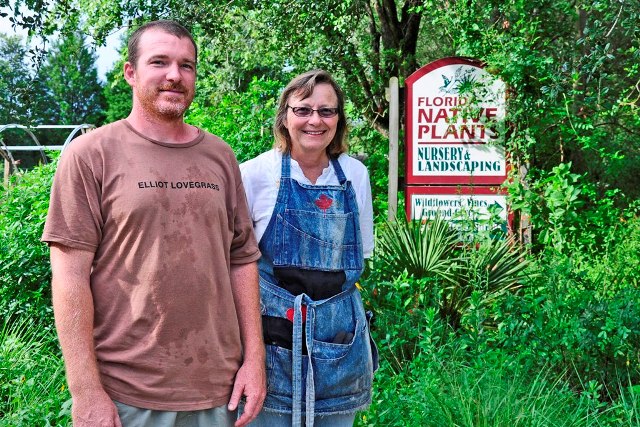 | | James Caudell and Laurel Schiller of Florida Native Plants Nursery in Sarasota County. |
Florida Native Plants Nursery in Sarasota is one of our newest Be Floridian partners. This family-owned, family-operated nursery in northeast Sarasota County has been in business for 30 years!
The nursery, open 7 days a week, features a huge variety of native wildflowers, groundcovers, shrubs and trees, as well as some non-native plants that have passed co-owner Laurel Schiller's "Florida Friendly" test. Herbs and an amazing assortment of unusual edibles also are available. No matter where in the Tampa Bay area you live, it's worth the drive to see the incredible variety of plants and the demonstration gardens. Click here for a look at the many demonstration sites you'll find on a visit. The nursery is now organically growing grapes in preparation for producing its own wine.
Florida Native Plants offers more than just plants -- staff will advise you on proper care and maintenance of your purchases. Landscape design, installation and maintenance services are also offered. If you are new to Florida native plants, the knowledgeable and passionate staff at Florida Native Plants Nursery will soon have you gardening like a True Floridian!
For location, hours and
other info, visit
| |
| | 
|
|
 |  |
Classes and workshops offer free or low-cost instruction on how to save time and money by practicing Florida-Friendly Landscaping™ principles. Check out your county extension service to get started or to learn advanced skills.
|
|
|
|
|
You're Grounded!
Why punish yourself all summer with constant mowing, weed-whacking and watering? Watch our video featuring Be Floridian partner Laurel Schiller of Florida Native Plants Nursery for ideas on attractive, easy-care ground covers that can used instead of grass, leaving you more time for FUN!
|
Be Floridian Video Series
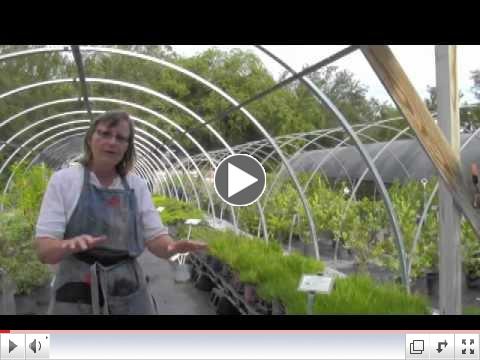 | |
Skip the Grass: Alternative Ground Covers |
|
|
|
MULCH MATTERS:
Which is best for your landscape?
|
Mulch is an essential element of a Florida-compatible landscape. Mulches prevent water loss through evaporation and help to buffer soil temperatures. Mulching can also inhibit weed germination or suppress weed growth.
Deciding which mulch to use depends on several factors, including your intended goal (adding color, ground cover, water retention) and your personal preference: -
 | |
Pine bark nuggets are a good choice for most home landscapes
|
If you're looking for a mulch that is resilient and maintains color, consider pine bark. Results from a University of Florida study showed pine bark had one of the lowest ranks for settling, meaning that pine bark maintained a useful depth for almost two years. In addition, test results indicated pine bark mulch retained its color longer than other mulches, up to two years.
- Although pine straw, or needles, can add some acidity to your soil (a plus for acid-loving plants like azaleas and camellias), its decomposition also ad
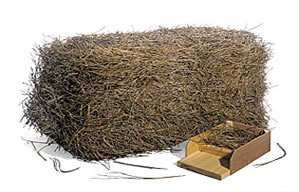 ds organic matter and nutrients. Although not as durable as pine bark, pine straw imparts an appealing soft, natural look to your landscape. Pine straw is sold in bales. ds organic matter and nutrients. Although not as durable as pine bark, pine straw imparts an appealing soft, natural look to your landscape. Pine straw is sold in bales.
- Eucalyptus will generally last longer in the landscape than pine straw, but not as long as pine bark. Eucalyptus also reportedly repels insects, including termites. It has a pleasing odor and holds color fairly well.
- Another termite-repeller, melaleuca, is also a durable choice. Plus, using this mulch (sold as "Florimulch") helps rid Florida of the very invasive melaleuca, or punk, tree, so users of this mulch get extra credit in the eco-friendly category!
-
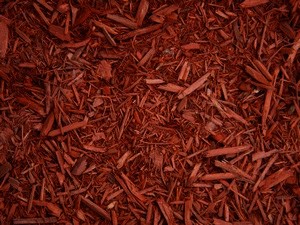 | |
Red-dyed mulch might look nice but fades quickly in direct sun.
|
Generic red mulch
is composed of wood chips dyed red. This mulch is inexpensive and used widely in commercial landscaping, however the color fades fairly quickly in the sun and can even leach into the soil in a heavy rain. Additionally, it is not as long-lasting as pine bark.
-
Finally, steer clear of cypress mulch. Although by far the best-selling mulch in Florida garden centers, it's made from slow-growing Bald Cypress and Pond Cypress trees found in freshwater wetlands. Production of Cypress mulch contributes to the destruction of these vital habitats.Using it in the landscape is not considered Florida-friendly.
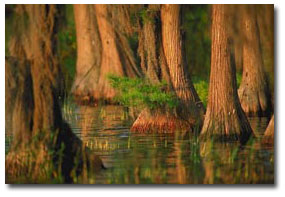 | |
True Floridians know that buying cypress mulch threatens beautiful wetlands like this.
|
Learn more about mulch, left, including how to use it correctly and where various mulches come from.
| |
|
Plants for True Floridians
Florida Native
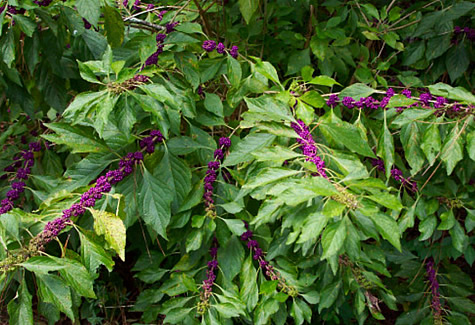
Beautyberry
(Callicarpa americana)
Expect some backyard visitors if you plant this hearty deciduous shrub that produces clusters of shiny purple berries in the fall -- they are an important late-winter food source for birds and other wildlife. Beautyberry is great for low maintenance landscapes; it's drought-tolerant and very adaptable to low-fertility soils. It does best in full to part shade, and is a perfect understory shrub for pines or oaks. This outstanding shrub needs some to room to spread out -- it can grow 6 to 8 feet tall and just as wide if you let it! Pruning in early Spring keeps it in check in home landscapes.
Florida Friendly/Non-Native
African Iris
(Dietes iridioides)
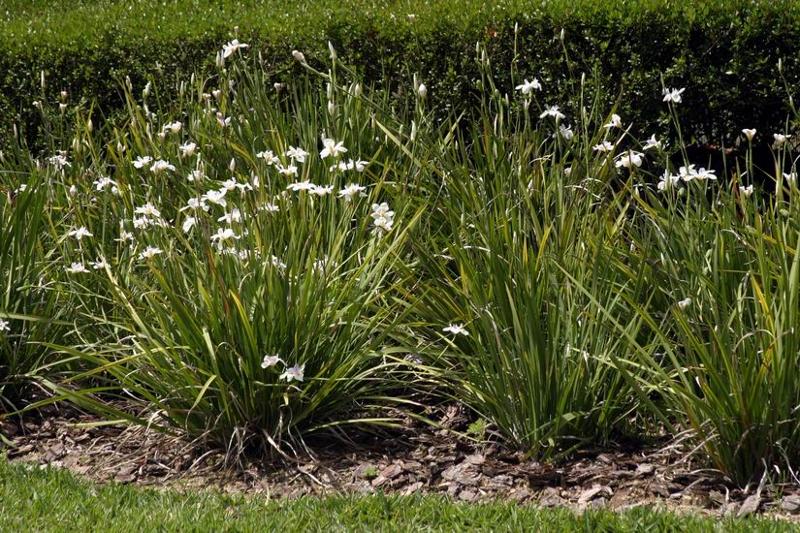 Yes, this pretty perennial iris does have African roots. The most common variety used in Florida has milky white petals with yellow markings, often with purple centers. Another common variety has yellow flowers. This tough-as-nails workhorse, characterized by clumps of leathery, sword-shaped leaves, thrives in full sun to part shade.Once established, it's a drought- and heat-tolerant superstar in almost any type of soil. African iris look great as a bed of border flowers or as a striking groundcover under large, tall trees. Yes, this pretty perennial iris does have African roots. The most common variety used in Florida has milky white petals with yellow markings, often with purple centers. Another common variety has yellow flowers. This tough-as-nails workhorse, characterized by clumps of leathery, sword-shaped leaves, thrives in full sun to part shade.Once established, it's a drought- and heat-tolerant superstar in almost any type of soil. African iris look great as a bed of border flowers or as a striking groundcover under large, tall trees. .
|
|
Recipes for Relaxing
|
Nothing says "summer relaxing" more than a bowl of fresh guacamole served with tortilla chips. Avocados and tomatoes are readily available now so go green and enjoy!
Guacamole
4 ripe large avocados, peeled, pitted
1/2 cup finely chopped onion
1/2 cup chopped seeded plum tomatoes
1/2 cup chopped fresh cilantro
1 4-ounce can diced mild green chilies, drained
1 to 2 teaspoons finely chopped seeded jalapeņo chilies
(wear gloves when handling hot peppers!)
Coarsely mash avocados in large bowl. Mix in onion, tomatoes, cilantro and canned chilies. Mix in jalapeņos to taste. Season with salt and pepper. Transfer to serving bowl and serve with tortilla chips. (Can be prepared 4 hours ahead. Place plastic wrap directly onto surface of guacamole and refrigerate.)
|
|
Garden Blogs Provide Information
and Inspiration
Gardeners love to share their knowledge, and taking advantage of that expertise is just a click away, thanks to a host of blogs maintained by avid Florida gardeners. Many of these bloggers are self-taught green thumbs; others are certified Master Gardeners or even pros in the nursery and landscape industry. Check out these Be Floridian favorites:
Garden Coach and Be Floridian partner Cynthia "Meems" Glover writes beautifully about her own ever-evolving garden. Her stunning photographs make this a mandatory stop on our weekly "blog patrols." Along with the elegant prose is a wealth of practical information on Florida-style gardening.
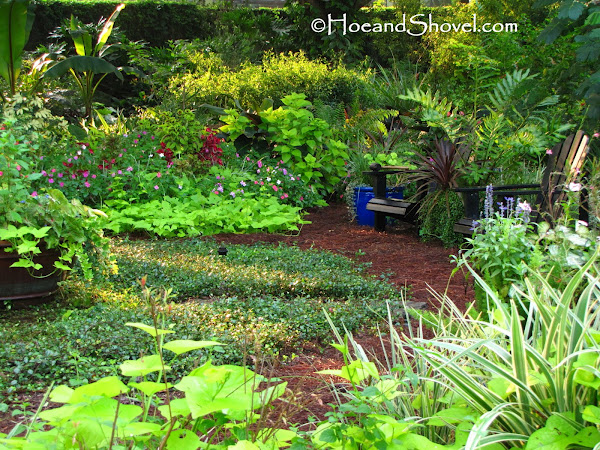 | | Circle Garden featured in Hoe and Shovel Blog |
Central Florida Gardener and Simply SusanBoth these blogs are the brainchild of t alented local gardener Susan. Central Florida Gardener is an online warehouse of great resources tailored specifically for Florida gardeners, while Simply Susan highlights aspects of Susan's own gorgeous landscape.
This blog chronicles the Extreme Yard Makeover tackled by Be Floridian coordinator Nanette O'Hara and husband Rick at their Tampa bungalow. Follow their ongoing yard adventures inspired by a desire to spend less time mowing, and more time fishing!
Great profiles of plants native to Florida, along with advice and useful resources for those wanting to landscape with natives.
|
|
|
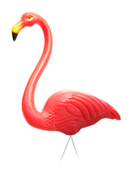 |
What's Be Floridian?
Be Floridian is an educational campaign sponsored by the Tampa Bay Estuary Program. Be Floridian partners include Manatee, Pinellas,
and Sarasota counties; the cities of Clearwater, St. Petersburg and Tampa; and a variety of landscape designers, gardening coaches, fertilizer companies and lawn care specialists. We are calling on all Southwest Floridians to help protect what makes Florida so fun -- our bays, lakes, rivers and the Gulf of Mexico -- by skipping the fertilizer in the summer to prevent water pollution.
|
|
|
|
|